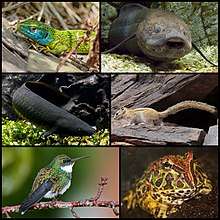Rhipidistia
The Rhipidistia, also known as dipnotetrapodomorphs (formally Dipnotetrapodomorpha)[1] are a clade of lobe-finned fishes which include the tetrapods and lungfishes. Rhipidistia formerly referred to a subgroup of Sarcopterygii consisting of the Porolepiformes and Osteolepiformes, a definition that is now obsolete.[2] However as cladistic understanding of the vertebrates has improved over the last few decades a monophyletic Rhipidistia is now understood to include the whole of Tetrapoda and the lungfishes.
| Rhipidistians | |
|---|---|
 | |
| Scientific classification | |
| Kingdom: | Animalia |
| Phylum: | Chordata |
| Clade: | Sarcopterygii |
| Clade: | Rhipidistia |
| Subgroups | |
Rhipidistia includes porolepiformes and dipnoi. Extensive fossilization of lungfishes has contributed to many evolutionary studies of this group. Evolution of autostylic jaw suspension, in which the palatoquadrate bone fuses to the cranium, is unique to this group.
The precise time at which the choana evolved is debated, with some considering early rhipidistians as the first choanates.
Relationships
The cladogram presented below is based on studies compiled by Philippe Janvier and others for the Tree of Life Web Project,[3] and Swartz 2012.[4]
| Sarcopterygii |
| ||||||||||||||||||||||||||||||||||||||||||||||||||||||||||||||||||||||||||||||||||||||||||||||||||||||
References
- Joseph S., Nelson (19 May 2006). Fishes of the World. John Wiley & Sons. p. 461. ISBN 978-0-471-75644-6. Retrieved 9 May 2015.
- "Encyclopædia Britannica". Retrieved 3 April 2014.
- Janvier, Philippe. 1997. Vertebrata. Animals with backbones. Version 01 January 1997 (under construction). http://tolweb.org/Vertebrata/14829/1997.01.01 in The Tree of Life Web Project, http://tolweb.org/
- Swartz, B. (2012). "A marine stem-tetrapod from the Devonian of Western North America". PLoS ONE. 7 (3): e33683. doi:10.1371/journal.pone.0033683. PMC 3308997. PMID 22448265.